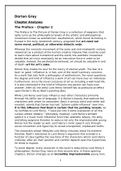Dorian Gray
Chapter Analyses
The Preface – Chapter 2
The Preface to The Picture of Dorian Gray is a collection of epigrams that
aptly sums up the philosophical tenets of the artistic and philosophical
movement known as aestheticism. Aestheticism, which found its footing in
Europe in the early nineteenth century, proposed that art need not
serve moral, political, or otherwise didactic ends.
Whereas the romantic movement of the early and mid-nineteenth century
viewed art as a product of the human creative impulse that could be used
to learn more about humankind and the world, the aesthetic movement
denied that art must necessarily be an instructive force in order to be
valuable. Instead, the aestheticists believed, art should be valuable in and
of itself—art for art’s sake.
Dorian Gray trades his soul for the luxury of eternal youth. The fear of a
bad—or good—influence is, in fact, one of the novel’s primary concerns.
As a work that sets forth a philosophy of aestheticism, the novel questions
the degree and kind of influence a work of art can have over an individual.
Furthermore, since the novel conceives of art as including a well-lived life,
it is also interested in the kind of influence one person can have over
another. After all, the artful Lord Henry himself has as profound an effect
upon Dorian’s life as Basil’s painting does.
While Lord Henry exercises influence over other characters primarily
through his skilful use of language, it is Dorian’s beauty that seduces the
characters with whom he associates. Basil, a serious artist and rather dull
moralist, admits that Dorian has had “[s]ome subtle influence” over him;
it is this influence that Basil is certain that his painting reveals. As
he confides to Lord Henry, “I have put into it some expression of all this
curious artistic idolatry.” Ultimately, however, Lord Henry’s brilliant
speech is a much more influential force than aesthetic beauty. His witty
and biting epigrams threaten to seduce not only the impressionable young
Dorian but the reader as well. Lord Henry’s ironic speech cuts through
social convention and hypocrisy to reveal unexpected, unpleasant truths.
The characters whose lifestyles Lord Henry criticizes resist his extreme
theories. Basil’s resistance to Lord Henry’s argument that scandal is a
function of class typifies the reactions of the characters whom Lord Henry
criticizes; after all, their position and comfort depend upon the hypocrisies
he tends to expose.
To some degree, every character in the novel is seduced by Lord Henry’s
philosophies, Dorian Gray more so than anyone else. In these opening
chapters, Dorian emerges as an incredibly impressionable young man,
1
,someone who Basil fears is open to the “influence” of Lord Henry, which
will “spoil” him. Basil’s fear is well founded, as before the end of his first
conversation with Lord Henry, Dorian is “dimly conscious that entirely
fresh influences were at work within him.”
Chapter 3 – 4
Dorian’s mysterious and melodramatic heritage alludes to conventions of
the Gothic novel: his wicked grandfather, his parents’ cursed elopement,
his father’s murder, and his mother’s early death represent a type of
moody romance popular among Gothic authors.
The first two chapters of the novel show Lord Henry’s powers of seduction,
but in Chapters Three and Four Lord Henry himself is seduced. Strictly
speaking, it is not a person who draws Lord Henry in, but the possibility of
having a profound effect on a person, namely Dorian: “there was
something terribly enthralling in the exercise of influence.” To project his
soul onto Dorian and seize his spirit just as Dorian has seized Basil’s
imagination becomes Lord Henry’s greatest desire.
In Lord Henry’s mind, life and art are not only connected but
interchangeable. By moulding Dorian into “a marvellous type” of boy,
Lord Henry believes that he is countering the effects of “an age so limited
and vulgar” as his own. He imagines that he will take his place among
such masters as the great Italian artist Michelangelo, with whom he
shares the imperative to create something of beauty. The fact that Lord
Henry considers the life of another human being a viable medium for
artistic expression indicates “[t]he new manner in art” that Wilde so
tirelessly advocated. Indeed, many readers might find Lord Henry
heartless, given his willingness to watch Dorian’s development with
practically no thought of consequence. After all, Dorian’s beauty is all that
matters to him, and “[i]t was no matter [to Lord Henry] how it all ended,
or was destined to end.” This behaviour merely links Lord Henry to the
tenets of aestheticism, whereby beauty is of primary importance, and vice
and virtue—as Wilde states in the novel’s preface—are nothing more than
“materials for an art.”
The opening chapters position the three main characters in a triangular
relationship, wherein Lord Henry and Basil vie for Dorian’s soul and
affections, Lord Henry quickly wins at the end of Chapter Three. In
Dorian’s declaration that he will miss his appointment with Basil in order
to hear Lord Henry speak, we see that Lord Henry’s hopes to dominate
and influence the young man have more or less been fulfilled. Dorian
gives his affections over largely because of Lord Henry’s conversational
skill; he asks Lord Henry to “promise to talk to me all the time.” Indeed,
Lord Henry is a great talker, a wonderful philosopher of “the new
Hedonism,” but, unlike Dorian, he acts on nothing that would damage his
respectable reputation or life.
2
,Chapter 5 – 6
Although Wilde stops short of stating that Basil and Lord Henry have
sexual feelings for Dorian, the language he uses to describe their devotion
to Dorian is unmistakably the language of deep, romantic intimacy.
Wilde’s language of irony facilitates dodging direct statements; in one
scene, for example, although the ostensible topic of conversation is
Dorian as a subject for portraits, the exchange between Basil and Lord
Henry betrays the romantic nature of Basil’s feelings.
Men do have relationships with women in the novel—Dorian falls in love
with Sibyl and Lord Henry himself is married—but the novel’s
heterosexual relationships prove to be rather superficial and short-lived. If
the novel is homoerotic, it is also misogynistic. Victoria Wotton, like most
of the women in the novel, is depicted with no real depth: she is briefly
(and not kindly) introduced, never to be heard from again. The most
significant female character in the novel is Sibyl, who seems to fulfil Lord
Henry’s observation that “[w]omen are a decorative sex.” There is
precious little substance to Sibyl’s character, as becomes clear in
following chapters when she so easily gives up her greatest talent in order
to pursue a relationship with Dorian. In this section, as she strolls through
the park with James, she emerges as a rather foolishly romantic young
woman. She is perfectly content to fall in love with a stranger whom she
knows only by the fairy-tale name with which she has christened him.
Indeed, Sibyl is little more than a placeholder in a prefabricated romance.
Dorian says nearly as much when he describes the thrill of seeing her
placed “on a pedestal of gold . . . to see the world worship the woman
who is mine.” This sentiment confirms Lord Henry’s ego-driven philosophy
of women as ornaments as well as the male-centred focus of Wilde’s
narrative gaze: men—particularly their relationships and the influence
they bring to bear upon one another—matter most in The Picture of
Dorian Gray.
More important than Lord Henry’s philosophy of the role of women,
however, is his insistence on the necessity of individualism. It was first
celebrated by the Romantics, who, in the early 1800s, decided that free
and spontaneous expression of the self was the true source of art and
literature. The Romantics rejected the eighteenth-century sensibility that
sought to imitate and reproduce the classical models of ancient Greece
and Rome, which were perceived as too stylized to allow for the
expression of anything genuine or relevant. Holding the self as the centre
of creation, Romanticism inevitably emphasized personal freedom,
sensory experience, and the special status of the artist. For although the
residue of the Romantic movement can be seen in Dorian’s story—Lord
Henry advocates that nothing should hinder the freedom of the artistic
individual’s development—the means by which that development occurs
in the story is noticeably different. In the world of The Picture of Dorian
3
, Gray, art is to be made by submerging oneself in society rather than
escaping from it.
Chapter 7 – 8
Dorian’s romance with Sibyl represents the possibility that he will not
accept Lord Henry’s philosophy and will instead learn to prize human
beings and emotions over art. His love for her allows him to resist Lord
Henry’s seductive words, noting to Lord Henry, “When I am with her, I
regret all that you have taught me. . . . [T]he mere touch of Sibyl Vane’s
hand makes me forget you and all your wrong, fascinating, poisonous,
delightful theories.” But just as Lord Henry appreciates Dorian as a work
of art rather than as a human being, what Dorian values most about Sibyl
is her talent as an actress—her ability to portray an ideal, not her true
self.
The extent of Lord Henry’s influence is painfully clear as Dorian
heartlessly snubs Sibyl, who claims that her real love for him prohibits her
from acting out such emotions onstage. Surely, to modern readers, Sibyl’s
devotion to Dorian—not to mention her grief over losing him—seems a bit
melodramatic. She is a rather thinly drawn character, but she serves two
important functions. First, she forces us to question what precisely art is
and when its effects are good. Second, she shows the pernicious
consequences of a philosophy that places beauty and self-pleasure
above consideration for others.
Sibyl’s claim that Dorian gives her “something higher, something of which
all art is but a reflection” stands in undeniable contrast to Lord Henry’s
philosophy, in which art is the highest experience and life imitates art
rather than vice versa. Indeed, time and again, Lord Henry delights in
ignoring the significance of human emotions. Even though Sibyl’s
conception of art as a reflection of grand emotions counters Lord Henry’s
philosophy of art, it resonates throughout the remainder of the novel.
Indeed, Sibyl’s philosophy is echoed in the very portrait of Dorian, since it
is a reflection of Dorian’s true self.
The answer to the narrator’s question as to whether the changing portrait
“[w]ould … teach [Dorian] to loathe his own soul” is yes, as Dorian grows
increasingly uncomfortable over the course of the novel with what the
disfigured portrait signifies about himself. As the novel progresses and the
painting continues to register the effects of time and dissipation, we see
the degree to which Dorian is undone by the sins that his portrait reflects
and the degree to which he suffers for allowing the painting to act as a
“visible emblem of conscience.” The aging of Dorian’s likeness in the
portrait ultimately contradicts some of Lord Henry’s beliefs about art: the
painting does not exist in a moral vacuum. Instead, the painting both
shows the deleterious effects of sin and gives Dorian a sense of
freedom from morality; it thus influences and is influenced by morality.
4





